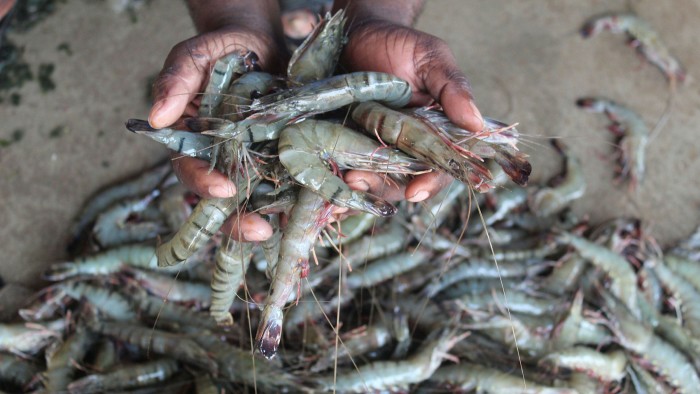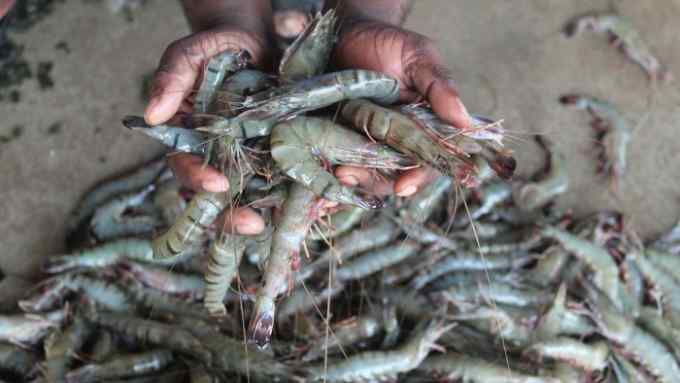India’s shrimp farms test antibiotic control

Roula Khalaf, Editor of the FT, selects her favourite stories in this weekly newsletter.
In markets from Boston to Beijing, much of the shrimp on sale comes from India, which has quickly grown into one of the world’s largest producers of the shellfish.
Globally, the shrimp export market was worth nearly $25bn in 2020, according to the UN Food and Agriculture Organization. And analysts, including those at Rabobank, estimate that India has become the world’s largest exporter by value.
Its shrimp exports jumped three-fold in the decade to 2020, to be worth about $5bn, according to the country’s ministry of fisheries. Notably, India is ranked as the number one shrimp supplier to the US, according to Farm Animal Investment Risk and Return Initiative (Fairr) — an investment advisory network focused on sustainable food production.
But this rapid expansion has also meant that the country’s shrimp industry has become a test case for whether authorities and producers in a fast-growing farming sector can control the use of antibiotics.
Experts say that, for producers in countries such as India, which often lack the infrastructure and resources of farmers in richer countries, the pressure to overuse antibiotics can be strong.
Like farmers in other sectors, many Indian producers use antibiotics to treat and control disease among their shrimp. However, regulators in Europe and elsewhere worry this can spill into misuse, such as using drugs to help healthy shrimp grow, with significant implications for global health.
Overuse of antibiotics for livestock and seafood production exacerbates the rise of antimicrobial resistance, in which drugs cease to be effective against infection. A study in The Lancet medical journal published this year found that more than 1.2mn people died from bacterial AMR globally in 2019. Medical researchers expect the toll to rise.
“The problem is going to increase as we intensify and try to produce more food,” says Charles Tyler, a professor of environmental biology at the University of Exeter, who has studied India’s shrimp industry. “That’s going to cause a massive burden in terms of disease. Whatever people say about AMR, it is going to get worse because of the way we’re producing food and the intensification of it.”
Indian shrimp became globally competitive as farmers intensified production, concentrating more and more shrimp into ponds and settling on high-yielding species like whiteleg shrimp.
Jennifer Cole, a lecturer in global and planetary health at Royal Holloway University in London, says the wetter climate and more frequent flooding in places like north-east India — a consequence of climate change — have also pushed farmers into aquaculture.
The industry’s intensification has led to diseases spreading more easily among shrimp. This can have devastating economic consequences for producers.
Because of the industry’s export-oriented nature, antibiotic use in shrimp in India is subject to tighter standards than other forms of animal agriculture, says Amit Khurana, director of the sustainable food systems programme at the Centre for Science and Environment think-tank in New Delhi.
Some also argue that measuring the scale of antibiotic overuse in the Indian shrimp industry can be difficult. But groups such as Fairr warn there is evidence of high usage as producers administer treatments preemptively or to promote growth.
In response, Importing nations have become stricter about India as a source of shrimp. The EU has increased the rate of testing for antibiotic residue in Indian shrimp shipments, according to a 2020 study of the sector for industry journal Reviews in Aquaculture. US regulators have even resorted to rejecting some Indian shipments after detecting antibiotics, according to US producer industry group the Southern Shrimp Alliance.
Tyler says some Indian shrimp farmers may use antibiotics during production but then stop doing so several weeks ahead of exporting their product in order to avoid detection. Producers counter-argue that they are being demonised by foreign inspectors, with excessively high testing standards leading to false positives.
Indian authorities have, nonetheless, taken note of the dangers, both health and financial, of antibiotic misuse in aquaculture. The fisheries ministry this year wrote to state governments across India warning about AMR and the potential harm to exports if antibiotic use is not curbed.
Jatindra Nath Swain, a secretary in the ministry, warned that authorities should “completely stop use of antibiotics and take steps against the violators”, according to the Down to Earth news website.
In 2017, India’s government launched a National Action Plan to tackle the broader issue of AMR by strengthening monitoring and raising awareness about the dangers. It has already banned dozens of antibiotics in aquaculture.
Even so, Fairr says Indian regulation is weaker than that of other large countries such as China and the US. The group argues that, with India’s federal system devolving significant powers to states, local initiatives would be more effective. Only three Indian states have their own AMR action plans.
Some analysts argue that, in an industry of many small producers with limited resources, farmers need to be given financial incentives to change their approach. Antibiotics remain the cheapest, and often only, option that farmers have to prevent crop failure, according to the Reviews in Aquaculture study.
“It’s very easy for us to see that there’s a need to reduce antibiotic usage,” says Philippa Thornton, an analyst at Fairr. But then “asking farmers — particularly in lower-income countries — to implement [alternatives] is much more difficult, particularly in the absence of financial capacity”.

Comments